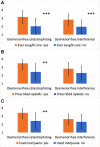Dysmenorrhea catastrophizing and functional impairment in female pelvic pain
- PMID: 36688085
- PMCID: PMC9853896
- DOI: 10.3389/fpain.2022.1053026
Dysmenorrhea catastrophizing and functional impairment in female pelvic pain
Abstract
Background: Dysmenorrhea is suggested to increase the risk of chronic pain by enhancing central sensitization. However, little is known about whether emotional and cognitive responses induced by dysmenorrhea contribute to chronic pain interference. This study examined the association between catastrophizing specific to dysmenorrhea and both dysmenorrhea and chronic pelvic pain (CPP)-associated pain interference.
Methods: Women (N = 104) receiving care for CPP through a tertiary gynecological pain clinic between 2017 and 2020 were recruited. They completed the Pain Catastrophizing Scale, the Brief Pain Inventory-pain interference, and a separate questionnaire regarding dysmenorrhea symptoms and treatment preceding the development of CPP. Dysmenorrhea catastrophizing and interference measures were developed and tested for internal consistency and construct validity. Multiple linear regression models examined dysmenorrhea catastrophizing in association with dysmenorrhea interference and CPP-associated pain interference.
Results: Dysmenorrhea catastrophizing and interference measures demonstrated excellent internal consistency (Cronbach's Alpha = 0.93 and 0.92 respectively) and evidence of construct validity (correlated with dysmenorrhea severity and treatment, Ps < 0.01). Dysmenorrhea catastrophizing was moderately correlated with pain catastrophizing (ρ = 0.30, P = 0.003), and was associated with greater dysmenorrhea interference (P < 0.001) and CPP-associated pain interference (P = 0.032) accounting for general pain catastrophizing and other outcome-specific confounders. Dysmenorrhea intensity was most predictive of dysmenorrhea catastrophizing.
Conclusion: Among our clinical sample of women with CPP, dysmenorrhea catastrophizing was associated with greater dysmenorrhea interference and subsequent CPP-associated pain interference. More research is needed to determine whether reduction in dysmenorrhea catastrophizing leads to reduced pain interference associated with female pelvic pain.
Keywords: catastrophizing; chronic pelvic pain (CPP); dysmenorrhea; menstrual pain; pain intensity; pain interference.
© 2023 Li, Kreher, Gubbels, Palermo, Benjamin, Irvine, Hart, Jusko and Seplaki.
Conflict of interest statement
The authors declare that the research was conducted in the absence of any commercial or financial relationships that could be construed as a potential conflict of interest.
Figures


References
-
- F. Visceral and other syndromes of the trunk apart from spinal and radicular pain (2012). In: Classification of chronic pain, second edition (revised) [Internet]. the International Association for the Study of Pain (IASP). Available from: http://www.iasp-pain.org/PublicationsNews/Content.aspx?ItemNumber=1673.
Grants and funding
LinkOut - more resources
Full Text Sources

